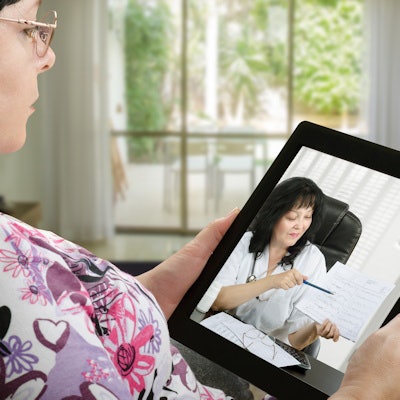
In response to the COVID-19 outbreak, Medicare has temporarily opened up the ability for physicians to provide medical care to patients without the need for them to be in the same physical location.
Beginning on March 6, 2020, and continuing through the end of the current COVID-19 public health emergency, the rules for providing telehealth services have been relaxed. Is there any opportunity for radiologists to use telemedicine in their practice?
 Sandy Coffta from Healthcare Administrative Partners.
Sandy Coffta from Healthcare Administrative Partners.Telemedicine is an activity in which a physician communicates directly with his or her patient without having a face-to-face interaction. Diagnostic radiologists usually are not involved in direct patient communication, instead reporting their findings to the patient's ordering physician. But such direct communication does take place in certain instances, such as mammography and biopsy procedures.
However, interventional radiologists and radiation oncologists perform evaluation and management (E/M) services routinely, and they will certainly be able to take advantage of these rule changes.
Impact of the temporary emergency rules
Telehealth is usually restricted to patients in underserved areas, such as outside a metropolitan statistical area or in a rural health professional shortage area. The emergency declaration issued March 17, 2020, broadened access to telehealth services to include patients and physicians regardless of their physical location.
Services billable under the telehealth provisions are primarily E/M in nature and include the office visit codes in the 99201 to 99215 range. The complete list of telehealth services is available from the U.S. Centers for Medicare and Medicaid Services (CMS) on its website.
Telehealth services are also usually restricted to patients with whom the physician has established a relationship through previous visits. The temporary waiver of the rules indicates that the existence of an established patient relationship will not be challenged on audit by CMS, therefore effectively allowing telemedicine services to be provided to new patients.
Physicians may use any interactive audio and video telecommunications system that permits real-time communication between the physician and the patient. This includes smartphones, tablets, or personal computers using software such as Apple Facetime, Google Hangouts, Skype, WhatsApp, Zoom, Doximity, or Facebook Messenger. Most of these communications programs are not secure and, in general, would not be acceptable; however, the HIPAA penalties that might otherwise apply are being waived during this public health emergency.
Physicians who make use of a telehealth visit will submit their claims to Medicare using the usual office visit codes of 99201 to 99205 for a new patient or 99211 to 99215 for an established patient. Inpatient or emergency department consults are billed using Healthcare Common Procedure Coding System (HCPCS) codes G0425 to G0427 and inpatient follow-ups are billed using G0406 to G0408. Telehealth visits are billed using Place of Service (POS) code 02 rather than the POS code for their physical location. In certain unusual instances, a modifier will be required; the most common might be the modifier G0 (telehealth services furnished for diagnosis and treatment of an acute stroke).
Documentation of the visit is required to support the claim just as it would be whenever billing for an in-person office visit. The information of the visit, the history, review of systems, consultative notes, or any information used to make a medical decision about the patient should be documented. It would be a good idea to also include a statement that the service was provided through telehealth, including the location of both the patient and the provider and the names and roles of any other persons participating in the telehealth service.
Reimbursement from Medicare for telehealth visits is at the same rate as payment for the code would be for a normal in-person visit, using the facility fee schedule whenever a site-of-service differential exists in the fee structure. Telehealth does not change the patient's responsibility for their coinsurance or deductible. However, physicians have the option under the emergency declaration to waive the collection of patient balances if they choose to do so; normally, Medicare does not allow physicians to forego collection of patient balances.
Other telemedicine billing opportunities
Even before the current public health emergency telehealth declaration, physicians had other ways to be reimbursed for the use of telemedicine to interact with patients.
A Virtual Check-in is described as a brief telephone communication (five to 10 minutes). This could be used by a radiologist to deliver imaging results to a patient. Billing is via HCPCS code G2012, described as follows:
Brief communication technology-based service, e.g. virtual check-in, by a physician or other qualified healthcare professional who can report evaluation and management services, provided to an established patient, not originating from a related E/M service provided within the previous seven days nor leading to an E/M service or procedure within the next 24 hours or soonest available appointment; 5-10 minutes of medical discussion.
Note that the patient must have an established relationship with the practice and that the patient must verbally consent to receive virtual check-in services. The communication only needs to use audio, such as a simple telephone call, not audio and video as is required under telehealth.
The other option is communication with a patient via an online patient portal, known as an e-Visit. This presumes that the practice or hospital has such a system in place, and the services must be initiated by the patient. CPT codes 99421 to 99423 are used for this type of visit.
A complete description of these services is contained in the Medicare Telemedicine Health Care Provider Fact Sheet issued March 17, 2020.
Commercial insurance
Commercial insurance carriers have modified their positions in response to the current public health emergency along with Medicare.
For example, UnitedHealthcare modified its telehealth policy on March 6, 2020, to conform with the Medicare guidelines. The insurer requires the use of modifiers to indicate the type of technology used and to identify the service as telehealth; the use of POS 02 is recognized but is not required.
Horizon Blue Cross Blue Shield in New Jersey is "waiving all member cost-sharing obligations for covered telemedicine services delivered by an in-network doctor or through Horizon's telemedicine platforms." Practices should check the requirements of each carrier to determine its requirements regarding telemedicine services.
Conclusion
While little has changed for diagnostic radiologists, the Medicare rules revision opens up an opportunity for interventional radiologists and radiation oncologists to add telemedicine as a tool for providing services, at least temporarily. By understanding the rules, reimbursement can be obtained for patient interactions that might otherwise have gone unbilled. Patients will appreciate the ability to visit with their physician without having to leave their homes.
Sandy Coffta is the vice president of client services at Healthcare Administrative Partners.
The comments and observations expressed are those of the author and do not necessarily reflect the opinions of AuntMinnie.com.



















